.jpg)
Renault Arkana Review
.jpg)
Introduction
Coupe-style SUVs are growing fast in terms of popularity, with a new manufacturer getting on board in some way, shape or form, just about every month.
Renault decided it needed something fresh to compliment the Kadjar and Captur SUVs it already sells. Voilà! The Arkana is arriving in the UK.
Select's rating score* - 3.3 / 5
At a Glance
It employs the powertrain used by the Captur and is based on the same platform. The Clio is, too, believe it or not – albeit it’s extended for the Arkana to fit its longer body. In fact, thanks to the French manufacturer dropping its larger models, this will be the biggest Renault that’s on sale over here.
In terms of looks, Renaults often divide opinion, and the Arkana is no different. The front is full of personality, with rounded lines and a reasonably bulbous shape giving it a more friendly than imposing view. However, it does have a tinge of sportiness to it, without looking overly aggressive or athletic.
The day-running lights run separately from the main headlights in a sort of ‘serif’ design, while the lower grille looks very wide, which adds something of a semi-restrained sporty look.

From the side, it takes inspiration from the likes of the BMW X4, with the sweeping curve downwards towards the back providing the desired hunchback coupe effect. Unfortunately, all cars that take on this coupe SUV style seem to look a bit awkward from the side, and the Ankara is no exception, looking like it's an enlarged hatchback on stilts.
The rear is likely to divide opinion, too. There are LEDs, which go through the Renault badge, spanning the whole width of the boot and growing out towards the edges of the car to encircle the reversing lights.
The looks indeed split the office in half, with some labelling it funky. In contrast, others thought it was ghastly. But, then, if you remember how futuristic the second version of the Renault Megane seemed when it was launched in 2002 (the one famed for the ‘shaking that ass’ advert), you'll know that Renault has never been afraid to rock the boat and push boundaries when it comes to styling.
Key Features
There are three trims to choose from.
The Iconic is the entry-level trim, featuring 17-inch diamond-cut alloys, automatic headlights, rain-activated wipers, and a rear-view camera. There are also USB ports, keyless entry and start, an electronic parking brake and electric windows. What's more, electric de-icing, cloth seats, a synthetic leather steering wheel and a seven-inch touchscreen on the infotainment system are included. Apple CarPlay/Android Auto connectivity is also part of the deal.
You also get a tonne of safety equipment, which we’ll come on to later.
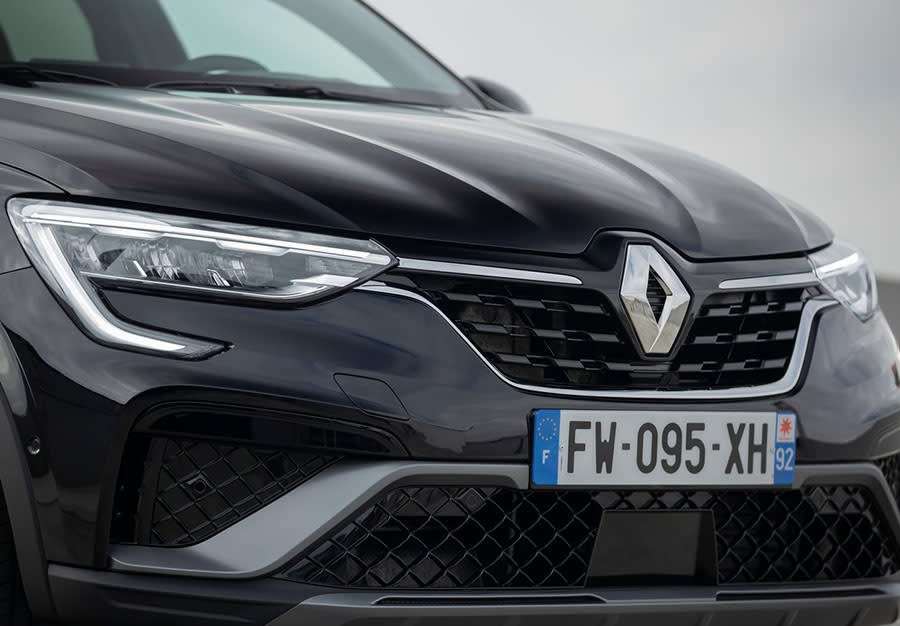
S Edition adds 18-inch alloys, automatic main beam, half synthetic leather upholstery, traffic sign recognition, adaptive cruise control and a speed limiter. At the same time, the infotainment system gets a bigger 9.3-inch screen, and the vehicle is connected via 4G with a three-year data plan.
RS Line is the top-spec, adding in hands-free parking, heated and electronically height-adjustable driver and passenger seats, and a heated steering wheel. There is also some additional exterior styling and red highlights on the alloys, steering wheel and dashboard. Furthermore, there's a carbon fibre-look trim on the interior, aluminium pedals, plus leather and imitation-suede seats and a leather steering wheel.
Each trim comes with two options for the powertrain.
The tongue-twisting ‘TCe 140 EDC’ is a mild-hybrid 1.3-litre four-cylinder turbocharged petrol engine producing 140PS, with a seven-speed automatic gearbox.
Alternatively, there’s the more subtly named ‘E-Tech hybrid 145 Auto’ full-hybrid. This houses a 1.6-litre four-cylinder petrol engine producing 94PS, combined with an electric motor which bumps the power up to 142PS.
Both are automatics and front-wheel drive only. There are no manual gearboxes available, nor is there an option for a four-wheel drive.
.jpg)
The TCe recharges through regenerative braking, converting the heat produced under braking into usable energy. This is stored away in the batteries underneath the passenger seat in the front, powering a small electric motor.
The engine in the E-Tech, on the other hand, has two electric motors, with batteries stored underneath the boot, with the charging again supplied by regenerative braking.
Renault anticipates about two-thirds of the Arkanas it sells to be the E-Tech – and around half of all models marketed are expected to have the top-of-the-range RS Line trim – so that’s what we’re driving.
Performance & Drive
The Arkana is reasonable to drive, but you quickly notice that performance most definitely isn’t its strong point.
Unlike the TCe, the E-Tech starts on electric power only, using the larger of the two electric motors to get going. The smaller one is only used when you demand extra energy, which brings the engine into play before too long.
But the 142PS combination isn’t much to write home about. The batteries add quite a bit of weight, and, sadly, the performance isn't outstanding. It takes nearly 11 seconds to reach 62mph from a standing start and, while the acceleration is smooth, the engine is loud and tends to scream a bit when it’s asked to work hard.
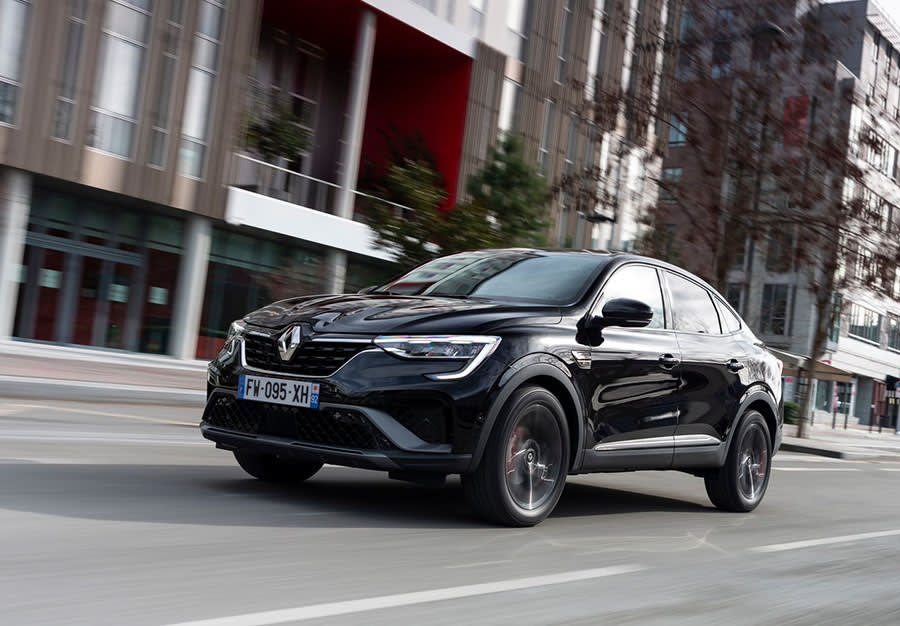
It tops out at 107mph, while the TCe is marginally quicker, getting from 0-62mph in just under 10 seconds and carrying on to a top speed of 127mph.
You do get decent acceleration at low speeds. But it doesn't feel especially athletic when you try to get, say, from 30 to 70 as the electric motor calls for assistance from the engine, which springs into life to help. The switchover is seamless, but at no point do you feel the car is in a rush to get moving, even with your foot buried to the floor.
With the added weight of the batteries, the handling is compromised somewhat. Renault appears to have compensated for this by giving it a reasonably firm suspension, and it's worked well. But the driving experience is not one you'd call sporty, despite the styling on the car.
The firm-ish ride doesn’t come at the expense of driving comfort, though. It smooths out lumps and bumps in the road reasonably well, and it handles corners impressively without too much body roll.
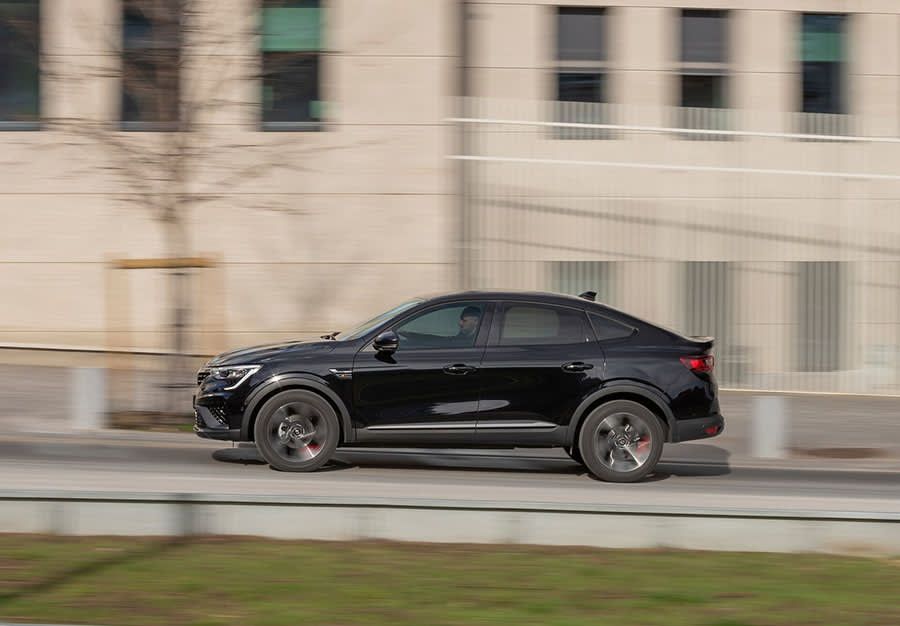
There is a sports mode, which sharpens the throttle input. This does improve the acceleration somewhat and delays upshifts to maximise the use of the rev range, making the steering heavier in the process. Still, it doesn't take away from the fact that the car feels like it's simply not up to the job if you're after performance.
Instead, the driving experience is more restrained, sophisticated and, if anything, relatively relaxed. As a result, the Arkana handles well without being agile, delivering you to your destination in a civilised way, free of boisterousness.
Despite the decent handling, though, it’s still a fairly sluggish and uneventful experience. Those seeking thrills will be left disappointed and may want to look towards a Cupra Formentor instead.
Running Costs & Emissions
The E-Tech 145 manages up to 58.9mpg, producing 108g/km CO2 in the process, which means it’ll be attractive as a company car due to its low tax band.
The TCe 140 EDC doesn't do quite so well but still manages up to 49.6mpg, with a CO2 figure of 130g/km, despite being around 100kg lighter than the E-Tech.
You get a five-year, 100,000-mile warranty – which is a relief, as Renault is not famed for its reliability. The automaker has come relatively low down in plenty of reliability surveys in recent times, so hopefully, the extended guarantee will be sufficient for some to overlook its record.
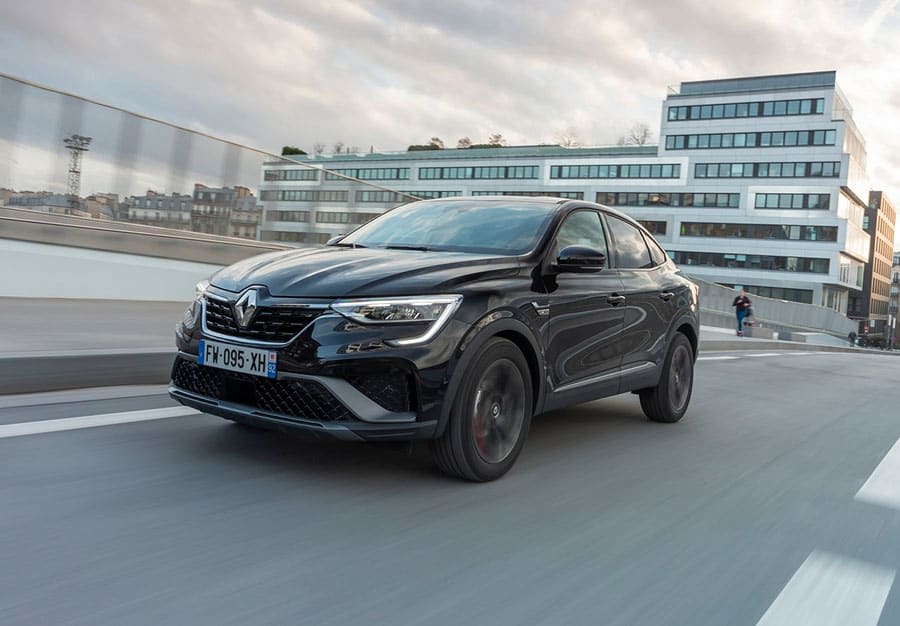
Interior & Technology
Inside, the Arkana is stylish, plush and full of gadgets and gizmos, and it feels sophisticated, albeit without the luxuriousness that you'd expect from premium manufacturers.
The infotainment system is excellent, with a responsive touchscreen and user-friendly design. We like it a lot – especially the 9.3-inch vertical screen, which is replaced by a smaller horizontal variant on the entry-level model. Some of the menus could be optimised a bit, but on the whole, it's well thought out, and the larger screen in our test car sprouts out from the dashboard like a tablet, but in an unintrusive way.

You also get a seven-inch digital instrument display, which gives you information on all the essential things you need to know about, although it's worth noting that this is only 4.2-inches on the TCe model. The display is customisable and looks classy, while there’s plenty of buttons to control various features on the steering wheel.
The seats are very comfortable and, while you feel pretty high up, you’re not much higher than you’d be in a regular coupe.
Those who despise the ever-more-popular trend of doing away with physical buttons in favour of controlling everything through the infotainment system will be pleased. Why? Well, there are still plenty of buttons to be pressed in the cabin, including the climate control system.
In terms of visibility, the windscreen pillars are a bit on the thick side in the front. They are even worse at the back, with the natural curving shape of the sloping roofline creating significant blind spots. Mind you, the rear-view camera, plus parking sensors get around the problem.
There's plenty of soft-touch plastics, and the interior is more admirable than the Toyota CH-R.
The cabin has plenty of space, so even taller drivers will cope, though the headroom could be better.
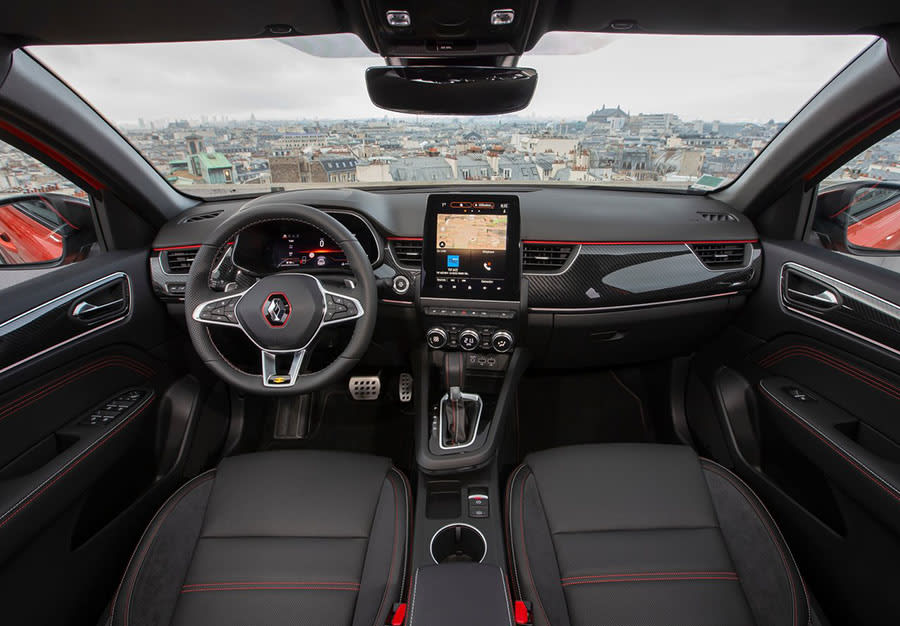
Storage is plentiful, with two cupholders, decent sized door bins, space between the gear selector and the dashboard, plus more stowage space below the front armrest.
There's a decent amount of legroom in the back, but taller passengers may struggle, especially as the drastically sloping roofline limits headroom.
A trio of adults in the back may be a squeeze and, if you’ve no choice and need to rest your arm on the door as a result, the windows don’t quite go all the way down.
The lack of a driveshaft to the rear means there’s no tunnel running through the middle under the floor, which is flat as a result.
Practicality & Boot Space
The Arkana E-Tech has a 480-litre boot, increasing to 1263-litres with the rear seats folded away.
In the TCe, the lack of batteries underneath the floor means that it has a bigger boot at 513-litres, increasing to 1296-litres.
By comparison, the Toyota CH-R only has 377-litres expanding to 1164-litres.

You get a two-tiered boot, too. This means you can store things away underneath the floor and then place other items above it. The raised boot base helps to minimise the boot lip, but it also means that what’s left of the cargo area is relatively shallow, limiting the height of items that can fit inside if they can’t be laid flat. The boot floor can be removed altogether, though. If you need to do this, be sure to remember before you leave home, or you’ll be forced to abandon either your large newly-bought Swedish self-assembly wardrobe or the boot.
The rear seats fold down in a 60:40 split.
Safety
Although the Arkana is new to the UK, it's been around for a while elsewhere. The model earned a five-star safety rating from Euro NCAP in 2019, scoring an impressive 96% for adult occupants, 83% for children and 74% for safety assists.
A lot of safety kit is provided, with traffic sign recognition, lane-keep assist, safety distance warnings and lane-departure warnings included as standard on all trims.
Automatic emergency braking is also provided across the range. At the same time, S Edition and RS Line trims get blind-spot monitoring as standard, along with rear cross-traffic warning, which will guide you when reversing.
Options
Annoyingly, Renault has joined the club of manufacturers who are happy to provide a car in any colour, as long as it’s the one they pick for you.
Of course, we don’t mean that literally – but what we do mean is, if you don’t want it in white, you need to pay extra, which is pretty poor in our view.
Metallic colours are blue, black and dark grey, and are available for an extra amount, while you can have the Arkana in a different sort of white or red if you pay even more.

We do understand shelling out for metallic paint, but Renault, along with many other offending car makers, need to do better with their choice of standard colours.
To add insult to injury, even a space-saver spare wheel costs extra.
On the other hand, the rest of the options list is, on the whole, fairly reasonable.
You can’t add very much to the entry-level trim, but you can add the Winter Pack on the S Edition model, which gives you heated front seats and a heated leather steering wheel. If you want the same but also want leather seats, it's a little more. Hands-free parking can be added, too.
On both the S Edition and RS Line trims, you can add Renault EasyDrive, which includes adaptive cruise control, stop and go and lane centring.
A sunroof is an option, too, and you can also elect to have a black roof.
Rival Cars
The most apparent nearest rival to the Arkana is the Toyota CH-R, and, in many respects, the Renault is the preferable option.
It has a nicer interior and is slightly cheaper, while the CH-R isn’t the solution if you are looking for more space in the back.
The Cupra Formentor is also worth considering. This car has a huge amount of kit - even on the entry-level models - and offers a better and more performance-focused, driving experience, with an even nicer interior to go with it. It is a bit more expensive, but its strengths are arguably the Arkana’s shortcomings, and you may consider it worth the extra money.
Finally, although the Renault isn’t all that comparable, if you want an SUV, it’s worth noting that an entry-level BMW X2 is less expensive than the top-of-the-range RS Line.

Verdict & Next Steps
The Renault Arkana is a good all-rounder without really excelling in any category.
It handles well, if unspectacularly, and it’s a bit on the slow side, but it offers sporty looks at a knock-down price compared with some of the competition.
While not particularly fast, the hybrid engines are at least impressively economical when you consider the size of the vehicle.
It’s got plenty of kit on it and, while it doesn’t have the performance to match the semi-sporty looks, the Arkana is a likeable car with personality in terms of styling, if not the driving experience.
In all honesty, we don’t really see the point in going for the RS Line, as the next trim down – S Edition – gets you all the major bits you need, unless the sports styling of the RS Line is of particular importance to you.
And, if it is, then it’s likely you’ll be expecting a car with more performance – and that’s definitely not the Arkana’s trump card.
Where to next?
View latest Renault Arkana leasing deals - guide price from £245 per month inc VAT**
Looking for a great leasing deal? Check out our incredible range of car lease deals
New SUV? Read our latest Reviews and find the right model for you
Want to know more about leasing? Take a look at our comprehensive Leasing Guides
Interested in everything motoring? Why not catch up on all the latest Car Leasing News.
*Score based on Select’s unique meta score analysis, taking into account the UK’s top five leading independent car website reviews of the Renault Arkana
**Correct as of 30/09/2021. Based on 9 months initial payment, 5,000 miles over a 48 month lease. Initial payment equivalent to 9 monthly payments or £2,206.22 Ts and Cs apply. Credit is subject to status.





















